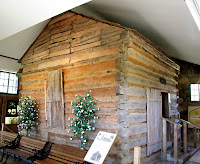We did have a big list of things we wanted to do in Fort Smith and this area but will just have to
save them for an other time we pass this way. She was felling a little better today and wanted to get out of the house so we took about a 15 mile drive to Sequoyah's Cabin.

Sequoyah was a Cherokee Indian that invented the Cherokee alphabet which enabled the Cherokee to read and write in their own language, At first he tried making a symbol for every word but after ten years he gave up on this idea just because there were to many words to learn the symbols for.

After he junked this idea he came up with a symbol or letter or the different sounds or spelling things phonetically. Sequoyah could not read, write or speak English but when he came up with his alphabet the five main sound were A E I O U and instead of sometimes Y his was sometimes V. The curator at the visitors center told us that the it was so simplified that he could teach anybody to read, write and speak Cherokee in under two weeks. They have a computer program that they type your name it and it comes out in Cherokee, Catherine is pronounced ge da qui ni and James is tse mi.
We already knew a lot about the Trail of Tears, over the years our travels have taken us to quite a few places along it, so he told us about all the different Indian Nations that were in Oklahoma and how it was divided up before becoming a state. As a matter of fact the people of the Oklahoma Territory took a vote and originally Oklahoma was going to be admitted to the Union as two separate States, the western half as Oklahoma and the eastern half as Sequoyah. But the powers in Washington DC decided that they didn't want two Democratic states coming into the union at the same time so they were combined as just Oklahoma. Half the vehicles have license plates that say Oklahoma (Native America) and the other half say Cherokee Nation, which are issued by the Cherokee Nation and not the state of Oklahoma. They have there own Police and Courts that work in conjunction with the state authorities, but the hard part to understand is that they is not specific territory since there are no reservations in Oklahoma, I really don't understand how the concept works but it does

He built the one room cabin in 1829 and lived in it until his death in 1843. The state took control of the property in 1936 (as a National Historical Landmark) and shortly after the WPA workers constructed the stone building around it to protect it. We were there just a little over a n hour but it seems like we learned five hour worth of stuff. The cabin is located about ten miles north of I-40 and if you're ever in the area during the hours it's open, it's worth the trip and time.

Just thought that this typewriter was interesting because it types Cherokee, look at the key board.

The log cabin on the left was added onto the cabin in later years to make it two rooms, when the WPA restored the cabin they removed this to make the cabin original. They then moved it to this location and made it the Visitors Center.
Lets see, what would the icing on the cake be for today, before we left the curator gave us directions to a little cemetery with an interesting grave, so that's where we went on the way home, see the photo below.

If you guess right then you're number 1, just like he was. If you haven't then change the Charley Arthur to "Pretty Boy" and you'll know who he is.
Notice how people have chipped away parts of the stone for keepsakes , the curator told us that they have replaced the stone something like 5 times.
Well I'll close by saying do na da go hv I , “Until we meet again”
